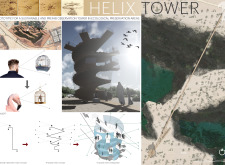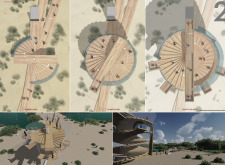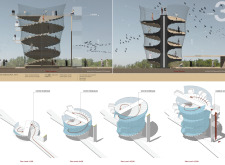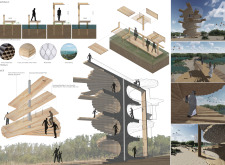5 key facts about this project
Sustainable architecture is at the forefront of this project, with a design that considers both functionality and environmental impact. The use of renewable materials and innovative construction methods underscores a commitment to ecological responsibility. Cross-Laminated Timber (CLT) forms the primary structural element, offering durability while minimizing carbon emissions. Vertical steel pipes provide necessary support without adding excessive weight, and the inclusion of metal mesh allows for safety while maintaining visual transparency. This choice of materials reflects a modern approach to design, balancing aesthetics with practicality.
Unique Design Approaches Enhancing User Interaction
The Helix Tower introduces a rotational design that promotes exploration and engagement. Each level of the tower features cantilevered platforms, designed for relaxation and observation. This configuration enhances user comfort while providing distinct vantage points for wildlife observation. The spiral staircase encourages visitors to ascend gradually, allowing for a more immersive experience as they traverse through varying heights and views.
The integration of observation decks at strategic points within the spiral structure provides educational opportunities for visitors. Detailed displays about the local ecology highlight the significance of the wetland, allowing users to gain insights into the environment while enjoying panoramic views. This thoughtful approach transforms passive observation into an active learning experience, setting the Helix Tower apart from conventional observation structures.
Architectural Details Supporting Sustainability and Structure
Incorporating shallow foundations, the design minimizes ecological disruption during construction. The combination of glass railings and metal mesh creates an unobtrusive barrier that preserves visibility while enhancing safety. The use of natural lighting through strategically placed windows reduces the need for artificial illumination, further contributing to the building's sustainability goals.
The Helix Tower showcases a seamless alignment of architectural design with environmental stewardship. By fostering a deeper connection between visitors and the wetland ecosystem, this project exemplifies how innovative architectural approaches can address contemporary environmental challenges.
For a thorough understanding of the Helix Tower and its architectural elements, including architectural plans, sections, and designs, readers are encouraged to explore the project presentation for more detailed insights into this distinctive approach to observation in a natural setting.


























